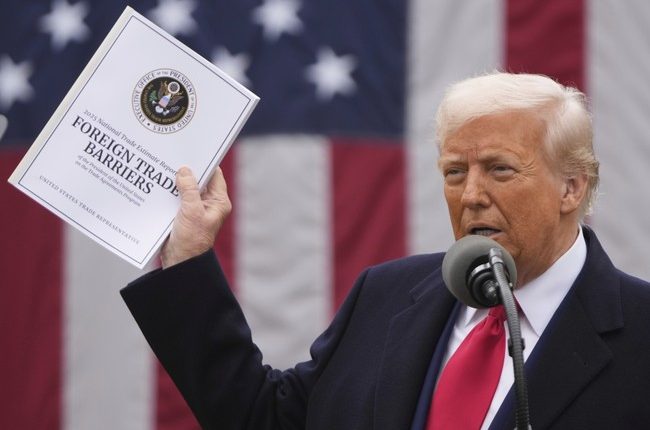
President Trump’s reciprocal tariffs went into effect at midnight last night and this morning the president had a simple message for the country who were feeling nervous about his moves.
As discussed yesterday, countries around the world seem to be heeding Treasury Secretary Bessent’s advice not to retaliate immediately but to see this as the opening move in a negotiation. Sec. Bessent said there were about 70 countries who were eager to have those conversations. The whole administration was delivering that same message yesterday.
“To countries around the world, bring us your best offers and he will listen,” Leavitt said of Mr. Trump. “Deals will only be made if they benefit American workers.”
Mr. Trump said Tuesday his administration was working on “tailored deals” with trading partners, and the White House said it would prioritize allies like Japan and South Korea.
His top trade official, Jamieson Greer, told a Senate panel Argentina, Vietnam and Israel were among those who had offered to reduce their tariffs.
However, China seems to see this moment as an opportunity to break from the US. It responded to Trump’s initial announcement last week with 35% tariffs of their own which were announced last Friday. The Chinese Commerce Minister vowed to fight the US tariffs “to the end.” And because China escalated, President Trump added an additional 50% tariff yesterday on top of what he had already set in place. Last night, that’s what took effect.
Counting existing levies imposed in February and March, that takes the cumulative tariff increase on Chinese goods during Mr. Trump’s second presidency to 104%.
He has insisted the ball is in China’s court, saying Beijing “wants to make a deal, badly, but they don’t know how to get it started.”
Today, China’s foreign ministry echoed the words of their Commerce Minister.
“If the U.S. genuinely wants to resolve the problem through dialogue and negotiation, it should show an attitude of equality, respect and mutual benefit,” Foreign Ministry Spokesperson Lin Jian said at a regular press briefing.
Echoing the commerce ministry’s comments on Tuesday, Lin said that “if the U.S. insists on fighting a tariff war and a trade war, China will “definitely fight to the end.”…
Nonetheless, Beijing said it hoped the U.S. would “meet halfway” and immediately lift the unilateral trade barriers, while reiterating its openness to strengthen dialogue, manage difference and boost collaboration.
So it appears that China does want to talk but more than anything, China does not want to appear weak. So today China also announced it was adding 50% to its own tariffs on US goods.
Tariffs on U.S. goods entering China will rise to 84% from 34% starting April 10, according to a translation of a Office of the Tariff Commission of the State Council announcement. The hike comes in response to the latest U.S. tariff increase on Chinese goods to more than 100% that began at midnight.
The tit-for-tat escalation of tariffs threatens to crush trade between the world’s two largest economies. According to the Office of the U.S. Trade Representative, the U.S. exported $143.5 billion of goods to China in 2024, while importing products worth $438.9 billion.
Sec. Bessent called this move “a loser” for China.
“It’s unfortunate that the Chinese actually don’t want to come and negotiate, because they are the worst offenders in the international trading system,” U.S. Treasury Secretary Scott Bessent told Fox Business on Wednesday after China’s latest announcement. “They have the most imbalanced economy in the history of the modern world, and I can tell you that this escalation is a loser for them.”
Where does this stop? I really don’t know. Trump could decide to add additional tariffs on China or this could slow down. One thing Sec. Bessent said to the American Bankers Association this morning caught my attention. “I think, at the end of the day, that we can probably reach a deal with our allies, with the other countries that have been long term, they’ve been good military allies, not perfect economic allies,” he said. And then he added, “And then we can approach China as a group.” That’s quite a few ifs at this moment but maybe that’s the larger plan. Here’s video of his comments.
Update (Ed): Looks like negotiations are the end goal after all. Trump has issued a 90-day pause to all new tariffs, except in the case of China:
Based on the lack of respect that China has shown to the World’s Markets, I am hereby raising the Tariff charged to China by the United States of America to 125%, effective immediately. At some point, hopefully in the near future, China will realize that the days of ripping off the U.S.A., and other Countries, is no longer sustainable or acceptable. Conversely, and based on the fact that more than 75 Countries have called Representatives of the United States, including the Departments of Commerce, Treasury, and the USTR, to negotiate a solution to the subjects being discussed relative to Trade, Trade Barriers, Tariffs, Currency Manipulation, and Non Monetary Tariffs, and that these Countries have not, at my strong suggestion, retaliated in any way, shape, or form against the United States, I have authorized a 90 day PAUSE, and a substantially lowered Reciprocal Tariff during this period, of 10%, also effective immediately. Thank you for your attention to this matter!
Let’s see how the markets react to this, but it seems smart to just focus on China.
Update (John): Trump did escalate on China yet again by another 21% (I thought he might). If China thought Trump was going to back down, they were wrong.
As I mentioned above, this also seems in line with what Sec. Bessent was saying to the American Bankers Association this morning. The larger plan is not just to negotiate better trade arrangements with our allies but also to “approach China as a group.” That seems to be the goal of singling China out in this way.
This is still a risky way to do things but the plan is coming into focus.






